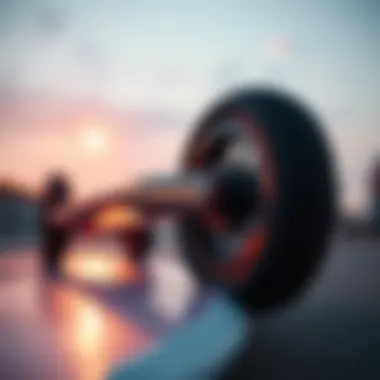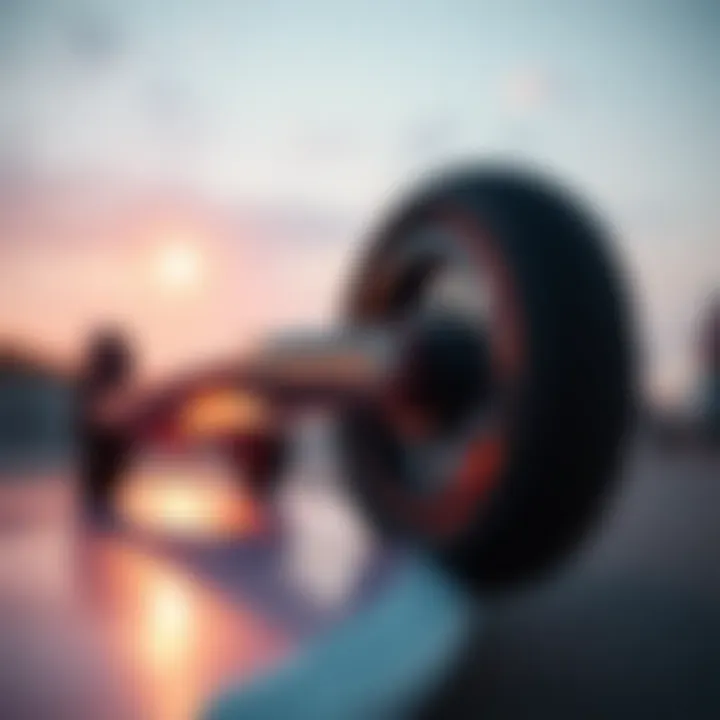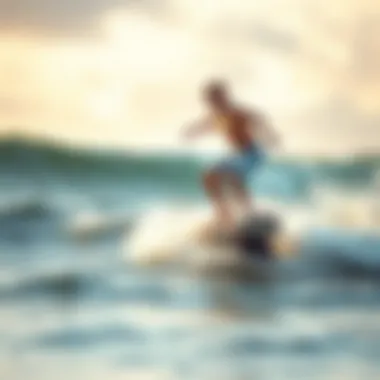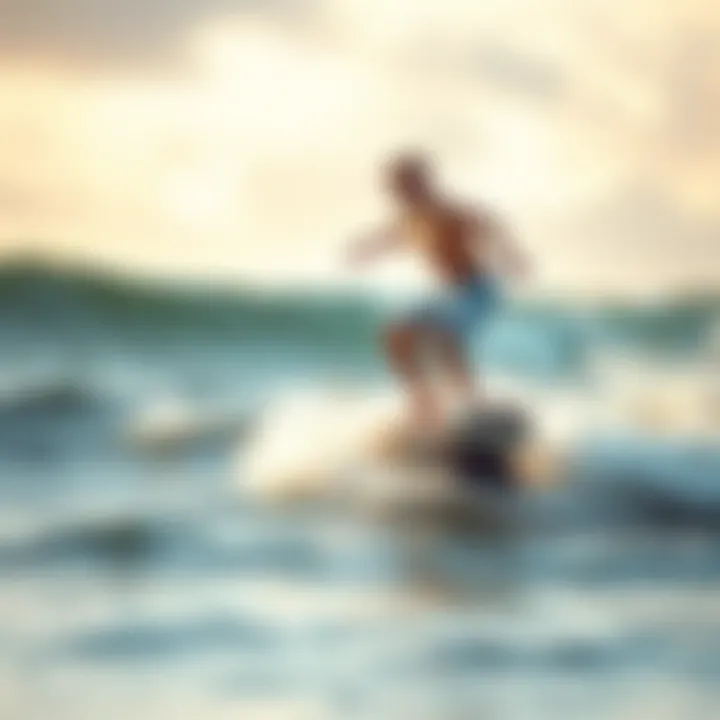The One Wheel Surfboard: A Comprehensive Guide


Intro
The evolution of water sports has been nothing short of radical, and one intriguing innovation making waves is the one wheel surfboard. Imagine cruising across the surface, gliding with the ease of a kiteboarder yet harnessing new techniques unique to this board.
The one wheel surfboard combines the thrill of surfing with the mechanical intuition of kiteboarding, creating a fresh narrative in an age-old sport. For both novices soaking up the sun and seasoned pros who’ve mastered the art of the wave, this board offers an experience unlike any other. As this article unfolds, we aim to dissect the multifaceted aspects of this innovative gear—from its design and functionality to its role in the kiteboarding universe, considering crucial topics like safety, maintenance, and even its potential environmental footprint.
So, whether you're contemplating investing in one or simply curious about its capabilities, this guide will shed light on every facet of the one wheel surfboard.
Foreword to One Wheel Surfboards
In the realm of water sports, the introduction of the one wheel surfboard stands as a noteworthy development, reshaping the dynamics of both traditional surfing and kiteboarding. This innovative equipment caters to a diverse audience, ranging from novices dipping their toes into the world of surfing to seasoned kiteboarders seeking fresh challenges. The one wheel surfboard isn't merely a tool; it represents a fusion of creativity and technology aimed at enhancing the overall riding experience.
Definition and Evolution
The concept of a one wheel surfboard is relatively recent but has rapidly gained traction among enthusiasts. At its core, it features a unique design that incorporates a single wheel—its presence fundamentally alters the way riders interact with the water. Unlike traditional boards that rely solely on buoyancy and balance, one wheel surfboards introduce a dynamic aspect of movement that is both exhilarating and challenging. The evolution of this device has been closely tied to advancements in materials and engineering, allowing manufacturers to craft boards that are not only lighter but also engineered to withstand the rigors of different water conditions.
As new players enter the market, the designs have diversified, employing various shapes and sizes suited for different styles and preferences. Riders are finding ways to push the limits of what these boards can do, blurring the lines between surfing, skating, and even snowboarding. The advent of electric propulsion also adds an exciting dimension to these boards, making them more appealing to an even broader audience.
Significance in Kiteboarding
In kiteboarding, the one wheel surfboard holds particular significance as it enhances maneuverability and provides a fresh take on this extraordinary sport. Riders who switch between traditional boards and one wheel surfboards often report varied experiences that challenge their skills in unique ways. The adjustments in foot positioning and weight distribution can teach valuable lessons about balance and control. Furthermore, the buoyancy and responsiveness of one wheel surfboards invite experimentation with tricks and transitions that are harder, if not impossible, to achieve on a standard board.
The significance isn't just limited to individual progression; it reshapes communal and competitive aspects of kiteboarding, as events begin to host categories that highlight innovative riding styles these boards present. Thus, one wheel surfboards are not just about catching waves; they're about redefining how enthusiasts engage with water sports.
"The thrill of riding a one wheel surfboard is akin to dancing with the ocean. Each twist, turn, and leap teaches the rider something new about balance, agility, and the joy of the ride."
In essence, as we journey further into the specifics of the one wheel surfboard, we will explore the structural intricacies, riding techniques, and broader implications of its use—each aspect illuminating how this board can revolutionize experiences on the water.
Design Features of One Wheel Surfboards
Understanding the design features of one wheel surfboards is crucial for both new and experienced kiteboarders. These boards are not merely unique in appearance but are carefully crafted to enhance performance, stability, and overall riding experience. When it comes to the world of water sports, the nuances of equipment can make a significant difference in performance and safety.
Construction Materials
The materials used in the construction of one wheel surfboards play a pivotal role in their performance and durability. Typically, these boards utilize a combination of lightweight composites, such as fiberglass and carbon fiber, alongside foam cores that provide both buoyancy and structural integrity.
- Fiberglass: Offers flexibility and strength, allowing for responsive riding.
- Carbon Fiber: Known for its lightweight properties, it increases speed and reduces fatigue.
- Foam Cores: Help to keep the board buoyant, adapting to different water conditions with ease.
Using high-grade materials not only optimizes the speed of the one wheel surfboard but also minimizes the risk of damage during rigorous rides. When selecting a board, understanding the quality and characteristics of these materials can greatly impact one’s ability to navigate through various water conditions.
Weight and Dimensions
Weight and dimensions are critical considerations to account for when choosing a one wheel surfboard. Riders should be mindful of how these factors influence maneuverability and stability in water.
An average one wheel surfboard typically measures between 5 and 7 feet in length. The width often ranges from 20 to 24 inches, providing ample surface area for paddling and riding. A common weight varies between 15 to 25 pounds; a lighter board can be an advantage for air tricks and quick turns. However, excess weight can lead to less control in choppy waters.
- Shorter Boards: Easier to turn and accelerate but may lack stability in larger waves.
- Longer Boards: Provide more stability and glide, making them better suited for beginners or those tackling larger swells.
Finding the right size is akin to tailoring a suit; it ensures comfort and maximizes performance. Thus, one should consider personal preferences, skill level, and the types of water conditions when selecting the appropriate design.
Stability Mechanisms
Stability mechanisms are vital for ensuring a smooth riding experience on one wheel surfboards. The unique design of these boards allows for various techniques and technologies to enhance stability—especially vital when tackling unpredictable sea conditions.


- Contoured Hull Design: Many one wheel surfboards feature a concave hull that helps collect water underneath to aid flotation while cutting through waves more efficiently. This design can mitigate the chances of nose diving or losing balance.
- Dynamic Weight Distribution: The single wheel setup allows weight to be cleverly shifted while riding. This is pivotal for maneuvering and achieving tricks. When riders lean, the board responds almost intuitively, making it easier to maintain stability.
- Fin Configuration: While many one wheel surfboards may have minimal or even absent side fins, some designs strategically incorporate them. The correct fin setup can improve grip and control, especially in larger waves.
"The design of a surfboard isn't just about looks; it's about creating an experience that empowers the rider."
The intelligent selection of these features helps determine the effectiveness and enjoyment of the one wheel surfboard experience.
Functionality and Performance
Understanding the functionality and performance of the one wheel surfboard is crucial for any rider looking to push their limits and enhance their kiteboarding experience. This unique board integrates innovative design elements that serve both beginner and advanced users alike, allowing for refined riding techniques, adaptability to various conditions, and an insightful comparison with traditional surfboards and alternative options.
Riding Techniques
Mastery of riding techniques on a one wheel surfboard is akin to learning a new dance. The rhythm and flow with the water are paramount. Unlike conventional surfboards, where balance tends to rely heavily on both feet being firmly positioned, the one wheel offers a different dynamic.
To get started, maintaining an upright posture while shifting weight towards the wheel is essential. Riders should learn to initiate turns by leaning in the direction they want to go, which not only helps in carving but also in maintaining speed through tight maneuvers. The subtle weight shifts required here might seem daunting at first, but with practice, it becomes second nature. Here are a few techniques worth mastering:
- Weight Distribution: Find your sweet spot on the board; it greatly affects stability.
- Carving: Use an edge-and-drop technique to carve smoothly, harnessing the wheel's dynamics.
- Speed Control: Riders should practice managing speed through body movements to ensure safe and exhilarating rides.
Handling Various Conditions
The one wheel surfboard thrives in diverse conditions, which makes it an exciting option for adventurous riders. Whether you're hitting calm waters or challenging waves, the adaptability of the board results in a thrilling experience. Here are some key aspects to consider:
- Wind Speed: Just like a kite in the sky, the wind plays a major role. Optimal performance typically thrives between 12 to 25 knots.
- Water Surface: Flat, choppy, or even small waves can significantly alter how you ride. This board helps maintain a solid grip during tough conditions, unlike traditional boards that may surface-to-surface grip can give out.
- Environmental Factors: The one wheel surfboard, with its design, allows for easier navigation over obstacles like submerged rocks or debris, giving riders a safety net in unpredictable environments.
Comparative Performance Analysis
When it comes to performance, understanding how the one wheel surfboard stacks up against traditional surfboards and other alternative boards adds depth to the riding experience.
Traditional Surfboards
Traditional surfboards have long been the go-to for many water enthusiasts. Their main draw lies in their simplicity and long history in the sport. One could say they’re the ‘old reliable’ in the surfing world. Their broad, stable outlines facilitate ease of paddling, and the performance in bigger waves remains unparalleled. However, they can be cumbersome in terms of maneuverability. Here are some points to keep in mind:
- Techniques Adaptation: Beginners find them approachable, as riding feels less complicated due to a wider base.
- Wave Interaction: Optimal for larger, powerful waves, pushing the limits further than the one wheel may allow.
- Transport and Storage: Storage can be a hassle as traditional boards are often larger and less portable than their one wheel counterparts.
Other Alternative Boards
Other alternative boards, like the foil surfboard or paddleboards, present varied approaches to riding. These boards have specific advantages, particularly regarding wave riding and versatility.
- Foil Surfboards: Offers an exciting, flying sensation once in motion. Riders can experience a unique glide over the water, reducing drag significantly. However, the learning curve is steeper than with one wheel surfboards.
- Paddleboards (SUP): Stand-up paddleboards bring in an element of fitness and leisure. They are excellent for flat waters, but transitioning to waves is less effective compared to the one wheel surfboard.
Understanding these differences can help riders make informed choices about gear that best suits their style and environment.
When considering options for riding, acknowledging the characteristics and capabilities of each board aids in refining one’s approach and maximizing performance in various conditions. Whether you’re carving through small waves on a one wheel or playing with more traditional boards, the water will always offer room for innovation and creativity.
Safety Considerations
When it comes to adventure sports like kiteboarding, safety cannot be overlooked. The thrill of riding a one wheel surfboard is undeniable, but it can also pose certain risks if riders do not pay close attention to safety considerations. Understanding the importance of this topic is crucial for ensuring a secure and enjoyable experience on the water, not just for yourself but also for those around you.
Proper safety protocols combine a layer of security with the joy of the sport. Riding can be unpredictable, and conditions can change rapidly. Therefore, being well-prepared with the right knowledge can make the difference between a sensational day on the water and a trip to the emergency room.
Furthermore, education about safety considerations helps promote a culture of conscientious riding among peers. This is not just about checking equipment; it entails a holistic approach to being aware of one's surroundings, understanding the limits, and preparing for the and unpredictable nature of water sports. Here, we’ll explore two significant aspects: personal protective equipment and how to navigate various hazards effectively.
Personal Protective Equipment


Investing in quality personal protective equipment (PPE) is a no-brainer for any one wheel surfboard rider. The right gear offers a safety net that can drastically minimize the severity of injuries resulting from falls or collisions. Key pieces include:
- Helmets: A sturdy helmet protects your noggin in case of unexpected falls or impacts. Consider helmets designed specifically for water sports, as they are typically lighter and more buoyant.
- Impact Vests: These floatation devices not only aid in buoyancy but also cushion impacts on the water, which can be quite unforgiving.
- Wetsuits: While protecting against cold water shock, wetsuits also provide additional insulation against scrapes that can occur from riding and falling.
- Footwear: Secure grip is essential. Specialized water shoes can help keep your footing while providing protection from sharp objects lurking beneath the surface.
Using these items is not just about compliance; it’s about enhancing performance and comfort. When equipment fits snugly and works well, it allows the rider to focus more on mastering their skills rather than worrying about unnecessary injuries.
“Safety is not just a set of rules, but a lifestyle that every kiteboarder should adopt to truly enjoy their ride.”
Navigating Hazards
Understanding how to navigate hazards is a fundamental component of kiteboarding safety, especially when it involves one wheel surfboards. Riders must be aware of their surroundings and anticipate the potential pitfalls that may arise. Here are some critical hazards to keep in mind:
- Weather Conditions: Sudden changes in weather can turn a calm day into a chaotic one. Always check forecasts and be mindful of quickly changing wind patterns that can affect your ride.
- Water Obstacles: Be wary of submerged rocks, reefs, or other structures that can cause serious injuries. Learning the area where you ride, including any common hazards, is a must.
- Other Riders: Crowded spots can lead to collisions. Keep your head on a swivel and communicate with fellow kiteboarders to maintain a safe distance from one another.
- Marine Wildlife: Encounters with animals like jellyfish or marine mammals can disrupt a ride. Awareness of local wildlife habitats helps inform cautious approaches around these creatures.
Riders should always conduct pre-ride checks, look for warning signs, and engage with experienced riders to gather insights on navigating local hazards effectively. When it comes to kiteboarding, your safety protects your adventure, so arm yourself with knowledge and sound judgment.
In sum, engaging with safety considerations is not merely an appendage to the excitement of the sport. It’s a fundamental aspect that, when prioritized, allows you to enjoy the ride with peace of mind.
Maintenance and Care
Proper maintenance and care is essential for ensuring the longevity and functionality of a one wheel surfboard. Just like any equipment designed for rigorous activities, neglecting its upkeep can lead to subpar performance and even safety hazards. This section discusses how routine inspections and diligent cleaning, coupled with appropriate storage techniques, can ensure an optimal riding experience.
Routine Inspections
Regular inspections of a one wheel surfboard allow riders to identify early signs of wear and tear. Riders should pay attention to several key aspects:
- Lagging Performance: If the surfboard feels sluggish or difficult to maneuver, it may be time to check for potential issues, such as tire air pressure or motor function.
- Visual Defects: A quick visual check can help catch cracks or scratches. Look for any abnormalities on the board surface, especially around the wheel and battery compartment. Small defects can often be repaired easily, preventing larger problems down the line.
- Electrical Components: Inspect the connections and wiring. A loose connection can cause erratic behavior. Ensuring that all components are secure results in a more predictable and safer ride.
- Tires and Traction: The tire itself demands attention. Look for any worn-out treads, as these can impact grip and stability on water. If the tread appears smooth rather than textured, it’s likely time for a replacement.
“Preventative maintenance saves time, money, and energy—much like choosing between a smooth ride or a bumpy one.”
By adopting a habit of scheduled checks, riders can minimize risks and maximize their time in the water.
Cleaning and Storage
Keeping a one wheel surfboard clean is not just a cosmetic issue; it's vital for performance and durability. After each adventure, if possible, rinse the board with fresh water to prevent salt and sand accumulation, which can corrode electrical components and damage the exterior.
Here are several cleaning tips to keep in mind:
- Rinse Regularly: After each use, a simple rinse with fresh water can remove harmful residues. If using a surfboard in salt water, this step is critical.
- Use Mild Detergents: For stubborn grime, opt for mild soap. Harsh chemicals may damage surfaces or affect performance.
- Dry Thoroughly: After cleaning, make sure the board is dried completely. Water trapped in compartments can lead to internal issues.
Storage is equally important for extending the life of the surfboard. Consider these points:
- Temperature Control: Keep the surfboard in a cool, dry place. Excessive heat can damage battery components and warping may occur if the board isn’t stored properly.
- Avoid Direct Sunlight: Long exposure to UV rays can fade colors and degrade materials. Use a protective cover if necessary.
- Horizontal Positioning: Store the surfboard horizontally rather than vertically to avoid undue stress on any one part of the board.
Incorporating these maintenance practices into routines ensures that the one wheel surfboard remains a reliable companion. By fostering respect and care for the equipment, riders can enjoy incredible experiences out on the water, while minimizing repairs and prolonging the surfing journey.
Environmental Impacts
Environmental sustainability is becoming a central concern across many industries, and the world of water sports is no exception. For kiteboarders and surfboard enthusiasts, understanding the environmental impacts associated with equipment like the one wheel surfboard is key to making informed choices. This section addresses how these surfboards are designed with sustainability in mind, as well as the broader implications for wildlife and natural habitats associated with their usage.
Sustainable Production Practices
The production practices of one wheel surfboards can significantly influence their overall environmental footprint. Traditional surfboard manufacturing often involves materials that are harmful both to the ecosystem and the health of the workers involved. However, many companies are now stepping up to the plate by adopting more sustainable methods. This shift encompasses a variety of practices, such as:


- Using Eco-friendly Materials: Manufacturers are increasingly utilizing bio-resins and recycled materials in the production of surfboards. These options reduce reliance on harmful chemicals and promote a circular economy.
- Energy Efficiency: Companies are also investing in energy-efficient production processes. Utilizing renewable energy sources, like solar power, helps reduce the carbon footprint associated with manufacturing.
- Local Sourcing: By sourcing materials locally, brands decrease transportation emissions and support local economies.
Investments in such sustainable practices not only enhance the appeal of one wheel surfboards but also resonate with consumers who prioritize environmental stewardship in their purchasing decisions.
Wildlife and Habitat Considerations
A surfboard that’s friendly to the environment is only half the battle; it’s also critical to consider the wildlife and habitats that may be affected by water sports activities. When kiteboarding with one wheel surfboards, practitioners tread a delicate line between recreation and conservation. Key considerations here include:
- Respecting Sensitive Areas: Riders should be aware of local wildlife habitats. For instance, breeding grounds for fish or nesting sites for birds should be avoided to prevent disturbance.
- Educating the Community: Encouraging responsible riding behaviors can help foster a culture of respect for the environment. This includes staying informed about local ecology and sharing insights with peers.
- Monitoring Ecosystem Health: There are ongoing studies looking into how water sports activity can influence aquatic ecosystems. Engaging with local research or conservation groups can provide insights into how to mitigate any adverse impacts.
Riding responsibly is not just about having fun on the water; it's about preserving that playground for future generations.
In summary, the environmental impacts of one wheel surfboards are multifaceted, involving everything from sustainable production practices to careful consideration for wildlife and habitats. As the sports community continues embracing equipment that aligns with eco-friendly values, we make strides not only in enhancing the sport but also in giving back to the environment that supports it.
Emerging Trends in Water Sports
The world of water sports is constantly evolving. The advent of new technologies and gear is reshaping how enthusiasts engage with activities like kiteboarding. One wheel surfboards are not just a passing fad; they represent a significant shift in equipment design and functionality. This article explores these emerging trends, driving the excitement and potential for experiences in water sports.
The one wheel surfboard serves as a prime example of innovative gear that is currently revolutionizing the landscape. With their unique design, these boards offer a novel way to carve through the waves. Riders looking to experience the thrill of riding a wave in a whole new way have found a compelling option in this type of board. Whether you're a seasoned kiteboarder or a rookie just cutting your teeth, emerging trends like this demand attention.
Adoption of Innovative Gear
The adoption of innovative gear fanatics ensures the continued growth of the sport and keeps it engaging. Take, for instance, a one wheel surfboard's ability to transform a mundane day at the beach into a thrilling experience. With the right gear, the craft can adapt to each rider's preferences. They deliver an exciting blend of balance, speed, and maneuverability.
As kiteboarding enthusiasts search for new ways to enhance their skills, the one wheel surfboard has captured attention due to several features:
- Dynamic Rider Engagement: Riders can enjoy a fresh challenge that requires a different set of skills compared to traditional boards.
- Versatile Usability: Perfect for flat waters, waves, or even choppy conditions, this board can adjust to various environments.
- Lightweight Construction: Made from high-performance materials, these boards remain agile and responsive.
The implications of adopting such innovative gear stretch beyond individual riders. As popularity rises, manufacturers might innovate further, leading to advancements in sustainability practices for production. Thus, the ripple effect of conscious consumerism becomes increasingly relevant in water sports.
"Embracing new gear like the one wheel surfboard signifies an evolving identity for water sports enthusiasts—melding thrill with environmental awareness."
Community Reception and Feedback
Community feedback is essential for the evolution of any emerging trend in sports. Synonymous with passion, kiteboarding thrives on shared knowledge, experiences, and advice. The one wheel surfboard has received mixed reviews, though many enthusiasts quickly hopped on its bandwagon.
Riders cite the following benefits:
- Enhanced Control: Many have praised the board's capacity for improved control during trick maneuvers.
- Social Interaction: The unique setup invites curiosity, prompting conversations amongst riders and spectators alike.
- New Skill Development: Many have reported taking leaps in their abilities, as the board encourages adaptability.
However, some have expressed reservations. Concerns include the learning curve and its performance limitations in extreme conditions. In practical terms, this translates to discussions within the kiteboarding community about how the gear modifies traditional practices.
Forums on platforms like Reddit showcase riders sharing stories and providing detailed accounts of their experiences with one wheel surfboards. Through these interactions, it’s apparent that while new gear can stir debate, it also fosters a sense of camaraderie—a hallmark of the water sports community.
As these trends take shape, the kiteboarding community will continuously influence gear development through their feedback. The future promises even more innovations that can expand the experience—ensuring the sport remains exhilarating for all participants.
Finale and Future Perspectives
In summing up the exploration of one wheel surfboards, it’s clear that this progressive surfing gear is not just a fleeting trend in the kiteboarding world, but rather a significant evolutionary step. The importance of understanding its multifaceted aspects lies in how it affects the riding experience for both seasoned surfers and newcomers alike. One wheel surfboards offer a fresh approach to the traditional surf experience, integrating technology with the thrill of riding the waves. Their unique design and functionality cater to a variety of riding techniques, ultimately enhancing performance whether one is navigating flat waters or tackling choppy seas.
Final Thoughts
Ultimately, as riders gravitate towards this innovative equipment, a deeper understanding of its characteristics becomes paramount. Insights drawn from this exploration emphasize that the one wheel surfboard is not merely about speed or agility; it’s also about versatility and adaptability across different conditions. Riders must comprehend these elements to fully embrace the potential of this surfboard variant. As such, engaging with the broader kiteboarding community—sharing experiences and learning from each other—can cultivate a richer surfing culture that thrives on experimentation and progress. It’s easy to see that riding the waves can be as much about brotherhood as it is about skill or equipment.
What Lies Ahead for One Wheel Surfboards
Looking forward, the trajectory for one wheel surfboards suggests potential advancements in design and technology. The ongoing push toward sustainability means that future models might employ even greener materials, which will resonate well with the environmentally conscious rider. Additionally, as manufacturers continue to refine the stability mechanisms and riding techniques, we might see a corresponding rise in their appeal among more traditional surfers hesitant to embrace such changes. The potential for integrating smart technology, perhaps with sensors to track performance metrics, isn’t out of the realm of possibility.
Beyond these enhancements, the community dynamics will play a central role in shaping the future narratives around these boards. As more enthusiasts try their hand at this sport, the feedback loop will inform manufacturers on what works and what doesn’t—creating a product that fits the demands of modern riders. Therefore, the essence of progression remains rooted in an open dialogue among kiteboarders. Future events and competitions will likely spotlight one wheel surfboards prominently, encouraging a culture that embraces novel approaches while respecting traditional roots in surfing.
In this context, it’s apparent that one wheel surfboards are not solely a novel gadget, but an integral part of what the future of water sports may hold. Whether through community engagement, tech innovations, or simply riding the waves, the journey of one wheel surfboards is just beginning.















